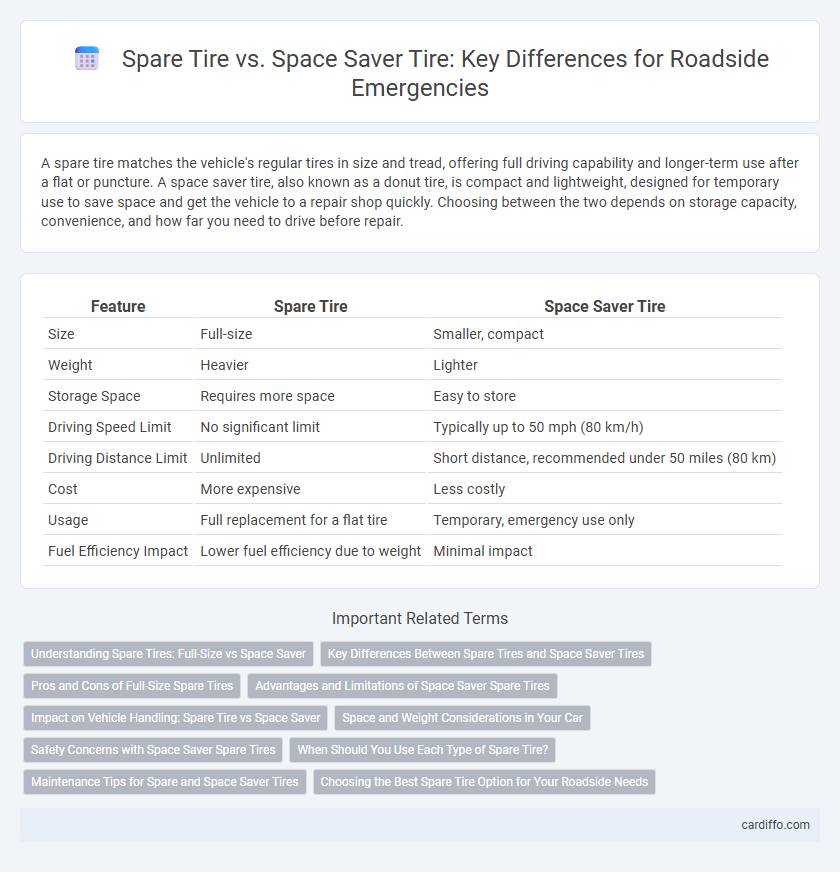A spare tire matches the vehicle's regular tires in size and tread, offering full driving capability and longer-term use after a flat or puncture. A space saver tire, also known as a donut tire, is compact and lightweight, designed for temporary use to save space and get the vehicle to a repair shop quickly. Choosing between the two depends on storage capacity, convenience, and how far you need to drive before repair.
Table of Comparison
| Feature | Spare Tire | Space Saver Tire |
|---|---|---|
| Size | Full-size | Smaller, compact |
| Weight | Heavier | Lighter |
| Storage Space | Requires more space | Easy to store |
| Driving Speed Limit | No significant limit | Typically up to 50 mph (80 km/h) |
| Driving Distance Limit | Unlimited | Short distance, recommended under 50 miles (80 km) |
| Cost | More expensive | Less costly |
| Usage | Full replacement for a flat tire | Temporary, emergency use only |
| Fuel Efficiency Impact | Lower fuel efficiency due to weight | Minimal impact |
Understanding Spare Tires: Full-Size vs Space Saver
Full-size spare tires match the vehicle's regular tires in size and performance, providing a reliable replacement for long-distance or high-speed driving without compromising safety. Space saver tires, also known as "donut" spares, are smaller, lightweight alternatives designed for temporary use, allowing limited speed and distance to conserve trunk space. Understanding these differences ensures proper tire choice during roadside emergencies, maintaining vehicle stability and control.
Key Differences Between Spare Tires and Space Saver Tires
Spare tires are full-sized replacements designed for temporary use, offering the same performance as regular tires but adding extra weight and requiring more storage space. Space saver tires, often called "donuts," are compact and lightweight, intended for short-term emergency use with speed limitations usually around 50 mph and restricted mileage up to 70 miles. The key differences lie in size, weight, durability, and usage limitations, where spare tires provide better performance continuity while space saver tires prioritize convenience and space efficiency.
Pros and Cons of Full-Size Spare Tires
Full-size spare tires offer the advantage of matching your regular tires in size and performance, providing reliable traction and handling during emergencies without compromising safety. Their durability and compatibility eliminate the need to adjust driving style or speed, making them ideal for long-distance travel or extended use. However, the increased weight and bulk can reduce fuel efficiency and occupy more storage space, which may be inconvenient for smaller vehicles.
Advantages and Limitations of Space Saver Spare Tires
Space saver spare tires offer advantages such as reduced weight and compact size, making them easier to store and handle during roadside emergencies. Their limited tread depth and smaller diameter impose speed and distance restrictions, typically not exceeding 50 mph and 50-70 miles, respectively. Although ideal for temporary use, they lack durability and performance compared to full-size spare tires, requiring prompt replacement to ensure vehicle safety.
Impact on Vehicle Handling: Spare Tire vs Space Saver
Spare tires typically match the original tire size and tread pattern, preserving vehicle handling and stability during use. Space saver tires are smaller and lighter, which can reduce traction, cornering ability, and braking performance, potentially compromising safety in emergency situations. Drivers should replace space saver tires with full-sized spares promptly to maintain optimal vehicle control.
Space and Weight Considerations in Your Car
Space saver tires occupy significantly less trunk space than full-size spare tires, making them ideal for compact car designs with limited storage capacity. Weighing considerably less, usually around 7-12 pounds compared to 20-30 pounds for standard spares, space saver tires improve fuel efficiency and reduce overall vehicle weight. These optimized dimensions help maintain drivability without compromising essential roadside emergency capabilities.
Safety Concerns with Space Saver Spare Tires
Space saver spare tires provide a temporary solution for roadside emergencies but pose significant safety concerns due to their reduced size and limited tread, which can compromise vehicle stability and braking performance. These tires typically have lower speed and distance ratings, requiring drivers to replace them with full-size tires promptly to maintain optimal control and safety. Using space saver spares beyond recommended limits increases the risk of tire failure and accidents, emphasizing the importance of understanding their limitations during roadside repairs.
When Should You Use Each Type of Spare Tire?
Use a full-size spare tire when your vehicle has enough space and you need to maintain optimal handling and performance during longer drives or high-speed travel. Space saver tires are ideal for short-term use in emergencies, offering a lightweight and compact solution to quickly replace a flat tire without occupying much trunk space. Prioritize a full-size spare if you plan extended trips or drive on rough terrain, while a space saver suits urban environments and temporary, low-speed travel.
Maintenance Tips for Spare and Space Saver Tires
Regularly check the air pressure in both spare tires and space saver tires to ensure they remain properly inflated, as underinflation can cause damage and reduce reliability during emergencies. Inspect the tires for any signs of cracking, dry rot, or punctures, especially if they have been stored for extended periods without use. Rotate spare tires periodically and clean off any debris or corrosion on the wheel to maintain optimal performance and extend their lifespan.
Choosing the Best Spare Tire Option for Your Roadside Needs
Choosing the best spare tire option depends on your vehicle type and driving requirements; a full-size spare tire offers the same performance and durability as your regular tires, making it ideal for extended use and high-speed travel. Space saver tires are compact, lighter, and easier to store but are designed for temporary, low-speed use only, typically up to 50 miles at 50 mph. Consider your typical roadside scenarios and storage space before deciding, ensuring your spare tire aligns with safety standards and manufacturer recommendations for optimal roadside support.
Spare Tire vs Space Saver Tire Infographic

 cardiffo.com
cardiffo.com